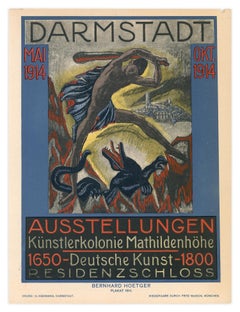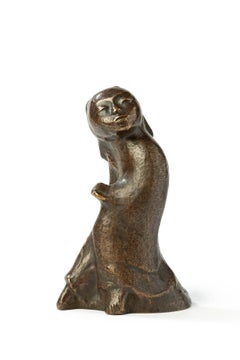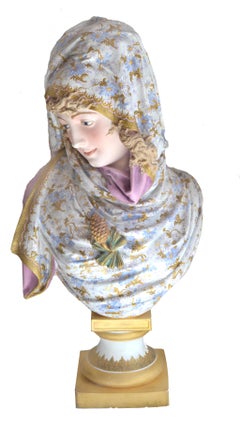Bernhard Hoetger Art
to
2
1
1
3
Overall Height
to
Overall Width
to
2
3
2
2
1
1
1
1
1
1
1
1
1
3
2
1
3
6,934
3,279
2,514
1,213
1
1
1
1
Artist: Bernhard Hoetger
Fourth Darmstadt exhibition, Expressionist dragon poster, Bernhard Hoetger, 1914
By Bernhard Hoetger
Located in Chicago, IL
Bernhard Hoetger’s 1914 Expressionist poster for the Darmstadt Artists' Colony’s (Darmstädter Künstlerkolonie) fourth and final exhibition depicts the legend of Saint George slaying ...
Category
1910s Expressionist Bernhard Hoetger Art
Materials
Offset
Bronze Sculpture "Japanese Dancer I" by Bernhard Hoetger
By Bernhard Hoetger
Located in Berlin, DE
Bronze with brown patina, 1923 by Bernhard Hoetger ( 1874-1949 ), Germany. Signed and numbered. Very good condition.
Height: 5.98 in ( 15,2 cm ), Width: 3.54 in ( 9 cm ), Depth: 2.44...
Category
1920s Expressionist Bernhard Hoetger Art
Materials
Bronze
Bernhard Hoetger Ceramic "Glaube" ( Faith ), 1912
By Bernhard Hoetger
Located in Berlin, DE
Statue from a cycle " Licht- und Schattenseiten" ( Light and shadows ) by Bernhard Hoetger ( Germany 1874-1949 ).
Ceramic, cream-colored glazed. Made by Tonwerke Kandern, 1912. On th...
Category
1910s Bernhard Hoetger Art
Materials
Ceramic
Related Items
After Albert-Ernest Carrier Belleuse Bisque Plotchrome Persian Maiden
By Albert-Ernest Carrier-Belleuse
Located in Soquel, CA
Bisque bust with ploychrome enamel decorated with painted gilt and raised on a circular socle with a square plinth. After Albert-Ernest Carrier-Belleuse by Ferdinand and Bing Co. an ...
Category
Early 1900s Aesthetic Movement Bernhard Hoetger Art
Materials
Enamel
Interrogation - Original Lithograph and Offset by George Grosz - 1925
By George Grosz
Located in Roma, IT
Interrogation is an original offset and lithograph realized by George Grosz.
The artwork is from the book "Kobes" by Heinrich Man, that Grosz illustrated with 10 drawings reproduce...
Category
1920s Expressionist Bernhard Hoetger Art
Materials
Offset, Lithograph
H 10.83 in W 8.67 in D 0.04 in
Greeting - Original Offset and Lithograph by George Grosz - 1923
By George Grosz
Located in Roma, IT
Greeting is an original offset and lithograph realized by George Grosz.
The artwork is the plate n. 5 from the portfolio Ecce Homo published between 1922/1923, edition of Der Malik...
Category
1920s Expressionist Bernhard Hoetger Art
Materials
Lithograph, Paper, Offset
H 13.98 in W 9.65 in D 0.08 in
The Art Wagon Galleries: Fritz Scholder (Reclining Woman) Poster (Signed)
By Fritz Scholder
Located in Saint Augustine, FL
Artist: (after) Fritz Scholder (Native American, 1937-2005)
Title: "The Art Wagon Galleries: Fritz Scholder (Reclining Woman)"
*Signed by Scholder in purple marker lower right
Circa:...
Category
1970s Expressionist Bernhard Hoetger Art
Materials
Lithograph, Offset
A Drink - by George Grosz - 1923
By George Grosz
Located in Roma, IT
Champagne is an offset lithograph, realized by George Grosz.
The artwork is the plate n. 77 from the porfolio Ecce Homo published between 1922/1923, edition of Der Malik-Verlag Berl...
Category
1920s Expressionist Bernhard Hoetger Art
Materials
Offset, Lithograph
Separe - Original Lithograph and Offset by George Grosz - 1923
By George Grosz
Located in Roma, IT
Separe is an original offset and lithograph realized by George Grosz.
The artwork is the plate n.22 from the portfolio Ecce Homo published between 1922/1923, edition of Der Malik-Ve...
Category
1920s Expressionist Bernhard Hoetger Art
Materials
Lithograph, Offset
H 13.98 in W 9.65 in D 0.04 in
Kunsthandel Wolfgang Werner KG (Nudes) /// German Expressionism Schmidt-Rottluff
Located in Saint Augustine, FL
Artist: (after) Karl Schmidt-Rottluff (German, 1884-1976)
Title: "Kunsthandel Wolfgang Werner KG (Nudes)"
Year: 1984
Medium: Original Offset-Lithograph, Exhibition Poster on yellow wove paper
Limited edition: Unknown
Printer: Unknown
Publisher: Kunsthandel Wolfgang Werner KG, Bremen, Germany
Framing: Recently framed in a contemporary black moulding with frame space
Framed size: 29.25" x 19.5"
Sheet size: 27.25" x 17.75"
Image size: 9.5" x 12"
Condition: In excellent condition
Extremely rare
Notes:
Poster produced for a special posthumous exhibition of Rottluff's early watercolors and printmaking "Schmidt Rottluff" at Kunsthandel Wolfgang Werner KG, Bremen, Germany from March 8 - May 12, 1984, in tribute to the artist's, would have been, 100th birthday.
GIA Gallery Poster Disclaimer:
Not to be confused with thousands of contemporary inkjet/giclée/digital reproductions ignorantly or deliberately passed off as originals on the market today. The examples we offer here are the original period vintage (exhibition) posters, created and designed by, or under the supervision and authorization of the artist or their respective estate (posthumously), for various exhibitions and events in which they participated. If applicable, this poster is also fully documented within its respective artists' official catalogue raisonné of authentic graphic works, prints, and or posters.
Biography:
Karl Schmidt-Rottluff (born December 1, 1884, Rottluff, near Chemnitz, Germany—died August 9, 1976, West Berlin [now Berlin]), German painter and printmaker who was noted for his Expressionist landscapes and nudes.
In 1905 Schmidt-Rottluff began to study architecture in Dresden, Germany, where he and his friend Erich Heckel met Ernst Ludwig Kirchner and Fritz Bleyl, two other architecture students who shared their passion for painting. Together they formed the organization of Expressionist artists known as Die Brücke...
Category
1980s Expressionist Bernhard Hoetger Art
Materials
Lithograph, Offset
Turkana Girl - Bronze African Tribe Sculpture, Limited Edition
Located in Pretoria, ZA
Bronze sculpture of young Turkana girl in traditional attire and characteristic hair style. The Turkana tribe, nomadic by nature, are a Nilotic people native to the Turkana District ...
Category
2010s Expressionist Bernhard Hoetger Art
Materials
Sandstone, Bronze
H 25.6 in W 6.7 in D 5.91 in
Roman 18th century terracotta model for the sculpture of San Camillo de Lellis
Located in London, GB
This remarkably fluid terracotta bozetto was made in preparation for Pietro Pacilli’s most important public commission, a large-scale marble statue of San Camillo de Lellis for the nave of St Peter’s Basilica in Rome. Expressively modelled, this terracotta sculpture is a rare and significant work made by a major Roman sculptor at a transformative moment of European sculpture. Pacilli began his working life on the great Baroque decorative projects initiated in the seventeenth century, but he found success as a restorer of ancient sculpture working to finish antiquities for a tourist market, becoming an important figure in the emergence of an archaeologically minded Neoclassicism. Pacilli trained Vincenzo Pacetti and provided important decorative work for the Museo Pio-Clementino, at the same time he is recorded restoring some of the most celebrated antiquities excavated and exported during the period.
Pacilli was born into a family of Roman craftsmen, his father Carlo was a wood carver, and Pacilli is recorded working with him on the Corsini Chapel in San Giovanni Laternao as early as 1735. In 1738 his terracotta model of Joseph and Potiphar’s Wife won the first prize in the second class of the sculpture concorso at the Accademia di San Luca, this is particularly notable as Bartolomeo Cavaceppi came third. He worked as a carver and stuccoist completing works for the churches of San Marco and SS. Trinita dei Domeniciani Spagnoli. Pacilli operated as a sculptor and restorer of antiquities from his studio at the top of the Spanish Steps, close to Santa Trinita dei Monti, where he is listed as a potential vendor to the Museo Pio-Clementino in 1770.
In 1763 Pacilli completed a silver figure of San Venanzio for the treasury of San Venanzio. He is recorded as Pacetti’s first master and it was evidently through Pacilli that he began to acquire his facility as a restorer of ancient sculpture. Pacilli, at his studio ‘poco prima dell’Arco della Regina alla Trinita dei Monti,’ exercised, what the nineteenth-century scholar, Adolf Michaelis called ‘rejuvenating arts’ on several important pieces of classical sculpture, including in 1760 the group of a Satyr with a Flute for the natural brother of George III, General Wallmoden, Hanovarian minister at Vienna. In 1765, Dallaway and Michaelis record that Pacilli was responsible for the restorations, including the addition of a new head, to the Barberini Venus which he had acquired from Gavin Hamilton. The Venus was then sold to Thomas Jenkins, who in turn passed it on to William Weddell at Newby Hall. In 1767 Pacilli exported a series of ancient busts ‘al naturale’ including portraits of Antinous, Julius Ceaser and Marus Aurelius, also a statue of a Muse and a Venus. As early as 1756 Pacilli seems to have been operating as an antiquarian, helping to disperse the collection of the Villa Borrioni. Pacilli supplied sculpture to notable British collectors, including Charles Townley, who on his first trip to Italy purchased the Palazzo Giustiniani statue of Hecate from Pacilli. Pacilli was involved with the Museo Pio Clementino from its conception, supplying busts of Julius Ceaser and a Roman Woman as well as completing stucco putti surmounting the arms of Pope Bendedict XIV to signal the entrance to the new Museo Critiano.
In 1750 Il Diario Ordinario del Chracas announced that Pacilli had begun work on a sculpture of San Camillo de Lellis for St Peter’s. Camillo de Lellis founded his congregation, the Camillians, with their distinctive red felt crosses stitched on black habits in 1591. Having served as a soldier in the Venetian army, Camillo de Lellis became a novitiate of the Capuchin friars, he moved to Rome and established a religious community for the purpose of caring for the sick. In 1586 Pope Sixtus V formerly recognised the Camillians and assigned them to the Church of Santa Maria Maddalena in Rome. Camillo de Lellis died in 1614 and was entombed at Santa Maria Maddalena, he was canonised by Benedict XIV on June 26, 1746. It was an occasion that prompted the Camillians to make a number of significant artistic commissions, including two canvases by Pierre Subleyras showing episodes from San Camillo’s life which they presented to Benedict XIV. In 1750 Pacilli was commissioned to fill one of the large niches on the north wall of the nave with a sculpture of San Camillo.
The present terracotta bozetto presumably had two important functions, to enable Pacilli to work out his ideas for the finished sculpture and at the same time to show his design to the various commissioning bodies. In this case it would have been Cardinal Alessandro Albani and Monsignor Giovan Francesco Olivieri, the ‘economo’ or treasurer of the fabric of St Peter’s. Previously unrecorded, this terracotta relates to a smaller, less finished model which has recently been identified as being Pacilli’s first idea for his statue of San Camillo. Preserved in Palazzo Venezia, in Rome, the terracotta shows San Camillo with his left hand clutching his vestments to his breast; the pose and action more deliberate and contained than the finished sculpture. In producing the present terracotta Pacilli has expanded and energised the figure. San Camillo is shown with his left hand extended, his head turned to the right, apparently in an attempt to look east down the nave of St Peter’s. The model shows Pacilli experimenting with San Camillo’s costume; prominently on his breast is the red cross of his order, whilst a sense of animation is injected into the figure through the billowing cloak which is pulled across the saint’s projecting right leg. The power of the restrained, axial contrapposto of bent right leg and outstretched left arm, is diminished in the final sculpture where a baroque fussiness is introduced to the drapery. What Pacilli’s terracotta demonstrates, is that he conceived the figure of San Camillo very much in line with the immediate tradition of depicting single figures in St Peter’s; the rhetorical gesture of dynamic saint, arm outstretched, book in hand, head pointed upwards was perhaps borrowed from Camillo Rusconi’s 1733 sculpture of St. Ignatius...
Category
18th Century Baroque Bernhard Hoetger Art
Materials
Terracotta
Rudi S. - Original Offset and Lithograph by George Grosz - 1923
By George Grosz
Located in Roma, IT
Rudi S. is an original offset and lithograph realized by George Grosz.
The artwork is the plate n.42 from the portfolio Ecce Homo published between 1922/1923, edition of Der Malik-V...
Category
1920s Expressionist Bernhard Hoetger Art
Materials
Lithograph, Paper, Offset
H 13.98 in W 9.65 in D 0.08 in
Hard Times - Original Offset and Lithograph by George Grosz - 1923
By George Grosz
Located in Roma, IT
Hard Times from is an original offset lithograph realized by George Grosz.
The artwork is the plate n.27 from the portfolio Ecce Homo published between 1922/1923, edition of Der Ma...
Category
1920s Expressionist Bernhard Hoetger Art
Materials
Offset, Paper, Lithograph
H 13.98 in W 9.65 in D 0.08 in
Tête de Faune, Picasso, Unique work, 1960's, Terracotta, Tiles, Design, Sculptur
By Pablo Picasso
Located in Geneva, CH
Tête de Faune, Picasso, Unique work, 1960's, Terracotta, Tiles, Design, Sculptur
Tête de faune
Unique work
14.03.1961
Painted and glazed terracotta tile...
Category
1960s Post-War Bernhard Hoetger Art
Materials
Terracotta
H 5.91 in W 5.91 in D 0.6 in
Previously Available Items
Der Bettler ( Le Mendiant )
By Bernhard Hoetger
Located in Berlin, DE
Presenting an old man in a coat, standing with an outstretched hand asking for alms, having taken off his hat.
Bronze dark patinated, circa 1902. Signed on the base Hoetger, Paris
...
Category
1920s Bernhard Hoetger Art
Materials
Bronze
Geiz ( Costiveness )
By Bernhard Hoetger
Located in Berlin, DE
A statue from a cycle " Licht und Schatten " ( Light and shadow ) by Bernhard Hoetger ( Germany 1874-1949 ). Made in ceramic, yellow glazed by Tonwerke Kandern, 1912. Inscribed on up...
Category
1910s Bernhard Hoetger Art
Materials
Ceramic
Licht - Buddha Vom Gluecklichen Lande
By Bernhard Hoetger
Located in Berlin, DE
Bernahard Hoetger ( 1874-1949 ), Germany, statue from a cycle "Lights and shadows", 1912
laughing Buddha on circular base
inscribed on left arm: Licht ( light )
signed and dated on t...
Category
1910s Bernhard Hoetger Art
Materials
Plaster
Bernhard Hoetger art for sale on 1stDibs.
Find a wide variety of authentic Bernhard Hoetger art available for sale on 1stDibs. You can also browse by medium to find art by Bernhard Hoetger in bronze, ceramic, metal and more. Much of the original work by this artist or collective was created during the 20th century and is mostly associated with the Expressionist style. Not every interior allows for large Bernhard Hoetger art, so small editions measuring 4 inches across are available. Customers who are interested in this artist might also find the work of Otto Mueller, Erich Heckel, and Conrad Felixmuller. Bernhard Hoetger art prices can differ depending upon medium, time period and other attributes. On 1stDibs, the price for these items starts at $1,400 and tops out at $21,800, while the average work can sell for $3,523.






